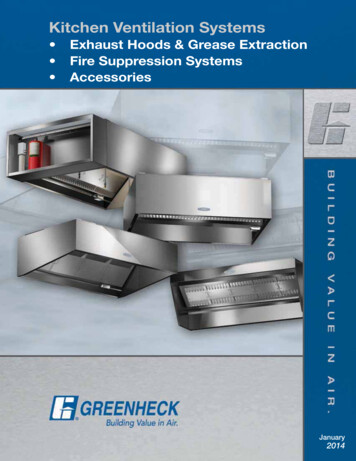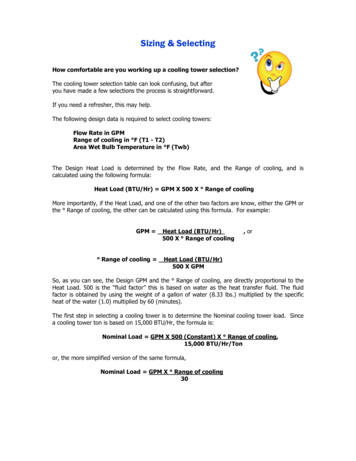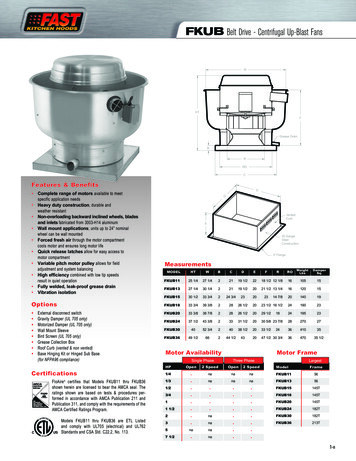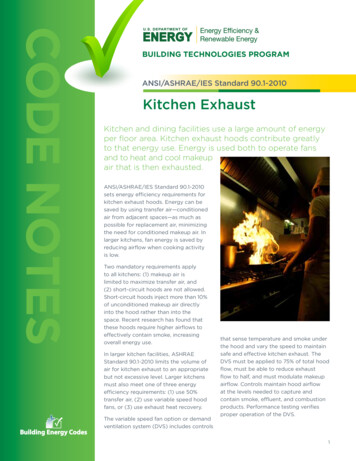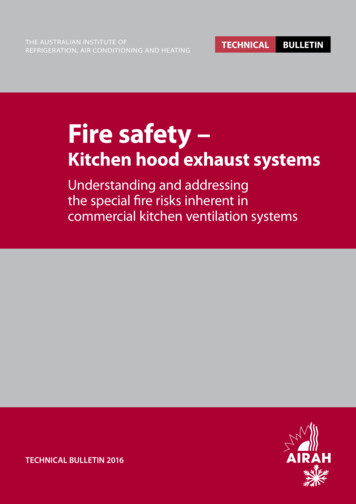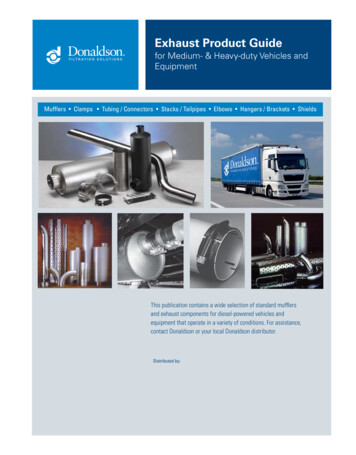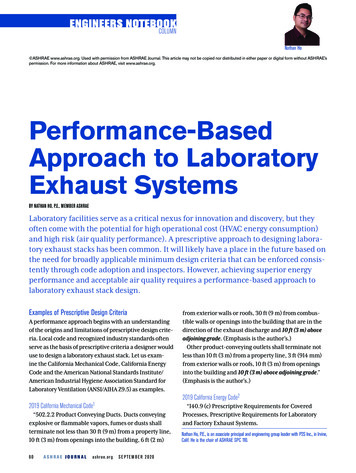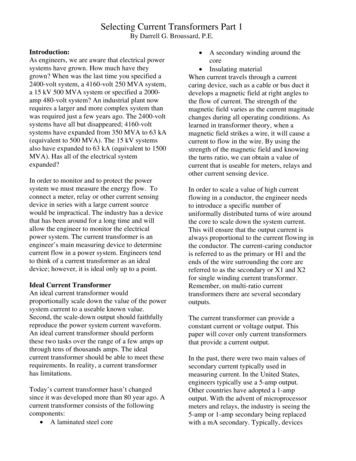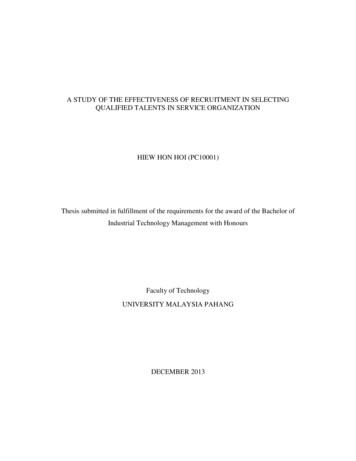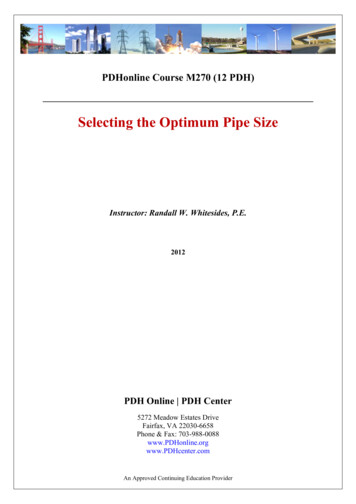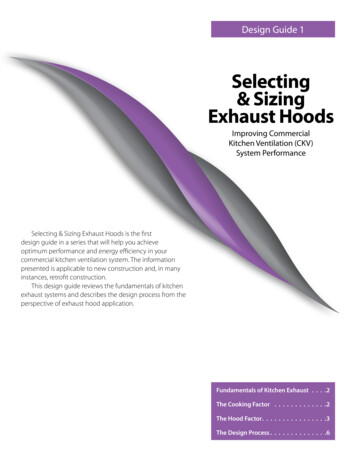
Transcription
Design Guide 1Selecting& SizingExhaust HoodsImproving CommercialKitchen Ventilation (CKV)System PerformanceSelecting & Sizing Exhaust Hoods is the firstdesign guide in a series that will help you achieveoptimum performance and energy efficiency in yourcommercial kitchen ventilation system. The informationpresented is applicable to new construction and, in manyinstances, retrofit construction.This design guide reviews the fundamentals of kitchenexhaust systems and describes the design process from theperspective of exhaust hood application.Fundamentals of Kitchen Exhaust 2The Cooking Factor 2The Hood Factor 3The Design Process 6
Fundamentals of Kitchen ExhaustHot air rises! In a kitchen, an exhaust fan may remove much of the heat produced bycooking appliances, but mix in smoke, volatile organic compounds, grease, and vapor fromthe cooking process and it becomes necessary to remove these products to avoid healthand fire risk. While an exhaust hood serves this purpose, a key question remains: “What is theappropriate exhaust rate for my kitchen operation?” The answer depends on several factors— the types of food products being cooked, the cooking equipment under the hood, thestyle and geometry of the hood itself, and how the makeup air (conditioned or otherwise) isintroduced into the kitchen.The Cooking FactorCooking appliances are categorized as either light-, medium-, heavy-, or extra heavy-dutydepending on the intensity of their thermal plume and the quantity of grease, smoke, heat,water vapor, and combustion products they produce. The intensity of the thermal plume is amajor factor in determining the exhaust rate. Thermal plumes rise, but are also turbulent andtheir “surge” characteristics can differ depending on the cooking method. For example, theplume from cooking hamburgers is strongest when flipping patties. Ovens and pressurefryers may generate little plume until opened to remove food product. Open-flame,non-thermostatically controlled appliances such as underfired broilers and open-top rangesproduce strong, steady plumes. Thermostatically-controlled appliances such as griddles andfryers have weaker plumes that fluctuate in sequence with thermostat cycling (particularlyin gas-fired equipment with flues). As the plume rises, it should be captured inside the hoodand removed by exhaust fan suction. Air in proximity of the appliances and the hood movesin to replace the exhausted plume. This replacement air, which must ultimately originate asoutside air, is referred to as “makeup air”. Design issues related to makeup air and its impacton hood performance are the subject of Design Guide 3: Optimizing Makeup Air.Building codes distinguish between cooking processes that create smoke and grease(e.g., frying, griddling, or charbroiling) and those that produce only heat and moisture(e.g., dishwashing and some baking and steaming operations). Cooking that producessmoke and grease requires liquid-tight construction with a built-in fire suppression system(Type I hood), while operations that produce only heat and moisture do not requireliquid-tight construction or a fire suppression system (Type II hood).Menu items can produce varying levels of smoke and grease depending on their fatcontent and mode of cooking. A hamburger cooked on a charbroiler releases finer smokeparticles and more grease than a hamburger cooked on a griddle for instance. However,higher fat content foods tend to release more smoke and grease regardless of cookingprocess. The high fat content of hamburger patties contributes to the significant amount ofgrease and smoke released during cooking. Conversely, chicken breasts have much less fatand as a result release less grease particulate whether cooked on a charbroiler or a griddle.2
The Hood FactorThe design exhaust rate also depends on hood style and construction. Wall-mountedcanopy hoods, island (single or double) canopy hoods, and proximity (backshelf, pass-over,or eyebrow) hoods all have different capture areas and are mounted at different heights andhorizontal positions relative to the cooking equipment (see Figures 1 and 2). Generally, foran identical cooking load, a single-island canopy hood requires more exhaust than a wallmounted canopy hood, and a wall-mounted canopy hood requires more exhaust than aproximity (backshelf ) hood. The performance of a double-island canopy tends to emulatethe performance of two back-to-back wall-canopy hoods, although the lack of a physicalbarrier between the two hood sections makes the configuration more susceptible to crossdrafts.Although a well-designed proximity hood can be applied with success at very lowexhaust rates (e.g., 150 cfm per linear foot over medium-duty equipment), proximity hoods(if specified without performance data and/or in accordance with maximum height andsetback permitted by code) may also fail to effectively capture and contain the cookingplume at exhaust rates of 300 cfm/ft or more. Figure 3 illustrates relatively effective andineffective applications of proximity hoods.Figure 1. Wall Mounted Canopy Hood.3
Single Island CanopyDouble Island CanopyPass OverBack ShelfEyebrowFigure 2. Other Styles of Exhaust Hoods.4
Effective Design with Side Panels Ineffective DesignFigure 3. Proximity Hood.Building and/or health codes typically provide basic construction and materialrequirements for exhaust hoods as well as prescriptive exhaust rates based on appliance dutyand hood length (cfm per linear ft.). Codes recognize exceptions for hoods that have beentested against a recognized standard such as Underwriters Laboratories (UL) Standard710. Part of the UL standard is a “cooking smoke and flare up” test, which is essentially acooking plume capture and containment test where “no evidence of smoke or flame escapingoutside the exhaust hood” must be observed. Hoods bearing a recognizedlaboratory mark are called labeled or listed hoods, while those constructed to the prescriptiverequirements of the building code are called code or unlisted hoods. Code hoods are becoming increasingly scarce in new installations and retrofit applications. The additional testingrequired of a listed hood is more attractive and less risky for the local code official. Generally,a listed hood can be operated at a lower exhaust rate than an unlisted hood ofcomparable style and size over the same cookline. Lower exhaust rates may be substantiatedby laboratory testing with specific hood(s) and appliance lineups using the test protocoldescribed in the American Society for Testing & Materials (ASTM) F1704 Test Method for Performance of Commercial Kitchen Ventilation Systems. This process is sometimes referred toas “custom-engineering” a hood.Laboratory hood testing with different combinations of appliances has demonstratedthat minimum capture and containment rates vary significantly with appliance type andposition underneath the hood. For example, a heavy-duty appliance positioned at the end ofa hood is more prone to plume spillage than that same appliance positioned in themiddle of the hood.5
Appliance Duty ClassificationsFrom CMCLight Duty Gas and electric ovens (including standard,bake, roasting, revolving, retherm, convection,combination convection/steamer, rotisserie,countertop conveyorized baking/finishing,deck, and pastry) Discrete element ranges (with or without oven) Electric and gas steam-jacketed kettles lessthan 20 gallons (76 L) Electric and gas pasta cookers Electric and gas compartment steamers (bothpressure and atmospheric) Electric and gas cheesemelters Electric and gas tilting skillets (braising pans) Electric and gas rotisseries Electric and gas salamandersMedium Duty Electric and gas hot-top ranges Gas open-burner ranges (with or without oven) Electric and gas flat griddles Electric and gas double-sided griddles Electric and gas fryers (including open deep fatfryers, donut fryers, kettle fryers, and pressurefryers) Electric and gas conveyor pizza ovensHeavy Duty Gas underfired broilers Gas chain (conveyor) broilers Electric and gas wok ranges Electric and gas over-fired (upright) broilersExtra Heavy Duty Appliances using solid fuel for cooking such ascharcoal, briquette, and mesquite to providethe heat source for cooking.The Design ProcessSuccessful application of the fundamentals of commercial kitchenventilation during the design process requires a good grasp of your localbuilding code requirements, menu and appliance preferences, and projectbudget. Information about kitchen equipment and ventilation requirementsmay evolve over the course of the design phase. Data needed by othermembers of the design team may require early estimates of certain parameters (e.g., the amount of exhaust and makeup air, motor horsepower, watersupply and wastewater flow rates). As more decisions are made, new information may allow (or require) refinements to the design that affect exhaustand makeup air requirements.The fundamental steps in the design of a CKV system are:1. Establish location and “duty” classifications of appliances includingmenu effects. Determine (or coordinate with a foodservice consultant)preferred appliance layout for optimum exhaust ventilation.2. Select hood type, style, and features.3. Size exhaust airflow rate.4. Select makeup air strategy; Size airflow and layout diffusers.Steps 1 through 3 are discussed in this guide and augmented in DesignGuide 2: Optimizing Appliance Position & Hood Configuration; Step 4 is thesubject of Design Guide 3: Optimizing Makeup Air.A good understanding of how building code requirements apply tokitchen design is essential. Local or state building codes are usually based onone of the “model” building codes promulgated by national code organizations.Our discussion of the building codes will be limited to requirements thataffect design exhaust and makeup air rates, which are usually found in themechanical code. The mechanical code establishes the minimum requirementsfor design and installation of mechanical (HVAC) systems, appliances,appliance venting, duct and ventilation systems, combustion air provisions,hydronic systems, and solar systems. The mechanical code is incorporatedby reference in the building code.Historically, codes and test standards used “temperature” ratings forclassifying cooking equipment. Although these temperature ratings roughlycorrelated with the ventilation requirement of the appliances, there weremany gray areas. During development of the ASHRAE Standard 154,Ventilation for Commercial Cooking Appliances, it was recognized thatplume strength (which considers plume volume and surge characteristics)as well as plume temperature would be a better measure for rating appliancesfor application in building codes. “Duty” ratings were created for mostcommercial cooking appliances under Standard 154. These ratings havebeen adopted by the International Mechanical Code (IMC), UniformMechanical Code, and the California Mechanical Code (CMC). The kitchenventilation chapter of the ASHRAE Applications Handbook (2019 edition)6
applied the same concept to establish ranges of exhaust rates for listed hoods1. The duty classificationslisted on page 7 are culled from the CMC.The IMC, UMC, and CMC dictate exhaust rates based on hood type and appliance duty. Table 1 statesthese exhaust rates in “cfm per linear foot of hood” (“linear foot” in this case applies to the distance fromedge-to-edge along the front face of the hood) for the UMC and CMC. Table 2 presents the exhaust ratesfor the IMC. The code requires that the exhaust rate for the highest duty-rated appliance be applied to theentire hood. The IMC, UMC, and CMC all require a minimum 6-inch hood overhang (front and sides) forcanopy style hoods.Light DutyEquipment200400250250250250Minimum Exhaust Flow Rates for Unlisted Hoods(cfm per linear foot of hood length)Medium DutyHeavy DutyEquipmentEquipment300550500700300550250not permitted300not permitted300not permittedExtra-Heavy DutyEquipment550700550not permittednot permittednot permittedLight DutyEquipment200400250250250250Minimum Exhaust Flow Rates for Unlisted Hoods(cfm per linear foot of hood length)Medium DutyHeavy DutyEquipmentEquipment300400500600300400250not permitted300400300400Extra-Heavy DutyEquipment550700550not permittednot permittednot permittedTable 1. CMC and UMC HoodExhaust Flow Rates.Type of HoodWall-mounted CanopySingle Island CanopyDouble Island CanopyEye BrowBackshelfPassoverTable 2. IMC Hood ExhaustFlow Rates.Type of HoodWall-mounted CanopySingle Island CanopyDouble Island CanopyEye BrowBackshelfPassoverThe prescriptive mechanical code exhaust rate requirements must be conservative because the AHJ(authority having jurisdiction) has no control over the design of an exhaust hood or the positioning anddiversity of appliances placed beneath the hood. However, in cases where the CKV system design andappliance configuration has been optimized, the code-specified exhaust rate may be significantly greaterthan what is required for effective capture and containment of the cooking plume. The code-based safetyfactor5 (which may be necessary for unlisted systems) can place an energy cost burden on the CKV systemthrough its demand for more heated and cooled makeup air.1The rule for unlisted hoods is to apply the duty rating for the highest duty appliance to the length of the entire hood (or separate section of hoodserved by an individual exhaust fan). For listed hoods, the same rule may be applied if little is known about the expected cooking operations. Ifdetails of the cooking operation are known, rates for each appliance may be applied and added up to determine the total exhaust rate.7
While the exhaust rates shown in Table 1 and Table 2 are the minimum mandatory ratesfor unlisted hoods, the rates in Table 3 reflect the typical range in design exhaust
Selecting & Sizing Exhaust Hoods is the first design guide in a series that will help you achieve optimum performance and energy efficiency in your commercial kitchen ventilation system. The information presented is applicable to new construction and, in many instances, retrofit construction. This design guide reviews the fundamentals of kitchen
